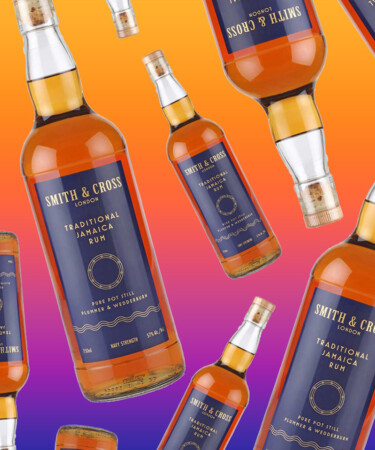With 200-plus years of history under its belt, Smith & Cross Jamaican Rum has been a stalwart player in the rum game for ages. It’s enjoyed back bar real estate through ever-changing trends, societal highs and lows, and tiki culture’s ebbs and flows. It’s 57 percent ABV, funky, and fruit-forward. And it’s surprisingly smooth when sipped neat, while proving equally versatile in countless cocktails. For those unfamiliar with Smith & Cross, read on to get better acquainted with this hogo-rich spirit.
The brand was born because of British sugar trading.
The Smith & Cross story began all the way back in 1788 at a London sugar refinery co-owned by two firms: Smith & Tyers and White Cross. Less than five years later, London’s West India Docks were built to accommodate the massive quantities of sugar and rum coming in from what was then the British colonies, particularly Jamaica. The aforementioned sugar refinery and its business partners quickly became major players in the Jamaican rum trade, setting up a slew of underground cellars along the River Thames. And thus, the Smith & Cross brand came to be.
It’s got major hogo.
Smith & Cross is famously rich in hogo. The term is derived from the French phrase “haut gout,” or “high game.” Originally used to describe game meat, it’s become part of the rum vernacular to express a funky, hard-to-explain quality often compared to baking spices, overripe banana, and cut grass with a light diesel undertone. A lot of the hogo character stems from the rum’s ester-friendly fermentation process. Esters are natural compounds produced during the fermentation process as wild yeasts react with molasses, most notably ethyl acetate and ethyl butyrate. These esters are further coaxed out by an extended fermentation period. While most Caribbean rums ferment for roughly 24 hours, Hampden Estate — the producer of Smith & Cross — lets fermentation run for two to three weeks, allowing all sorts of wild flavors to develop. Meanwhile, muck — a mix of leftover liquids from previous fermentations — gets added to the ferment, drawing out even more esters.
Tiki cocktails and Smith & Cross are a perfect match.
Any legitimate tiki enthusiast will tell you that Smith & Cross is a must-have bottle for any worthwhile Tiki bar. Sure, no one’s going to stop you from using this rum in a Daiquiri or Dark ‘n’ Stormy, but its full mixology potential really shines in tropical builds. Take the overproof liquid for a spin in a Mai Tai, a Zombie, or a Jungle Bird. Its strong aromas of overripe banana make the perfect companion for falernum, orgeat, Demerara syrup, and any number of fruit juices.
Smith & Cross inspired the Kingston Negroni.
The story of the Kingston Negroni begins at New York City’s Death & Co. in 2009. One fall afternoon, while bartenders Phil Ward and Joaquín Simó were behind the stick, Minnesota Liquor importer Eric Seed rolled into the cocktail bar with a bottle of Smith & Cross in hand. Simó took one whiff and exclaimed, “Hey, it’s got the hogo!” He rolled up his sleeves and immediately got busy building a rum-based Negroni. The drink debuted on the bar’s spring menu in 2010, becoming an instant hit and securing its spot as a canonical modern classic.
It offers some of the best bang for your buck in quality, high-proof spirits.
There are exceptions to the rule, but more often than not, high-proof spirits tend to get pricey. Luckily, Smith & Cross avoids that pitfall: It’s high-quality high-proof, but doesn’t cost an arm and a leg. Depending on the retailer, a bottle will generally cost between $28 and $35. Considering all the factors that make this rum special, that’s a steal.
Smith and Cross is bottled by a London gin company.
Smith & Cross’s two base rums are made in Jamaica, but they’re actually shipped overseas to London’s Hayman Distillers to be blended and bottled. Not only is the Hayman family the oldest gin-distilling family in London, but they’re responsible for some of the most famous gins on the market, including Beefeater and — you guessed it — Hayman’s.
Smith and Cross is a blend of Wedderburn and Plummer styles of rum.
The rum’s label proudly states that Smith & Cross is composed of pure pot still Plummer and Wedderburn. These two distinct rum styles are named after Thomas Plummer and John Wedderburn, rum merchants who invested large sums of money into the building of the West India Docks, the former epicenter of the British rum trade. Both styles are chock full of esters and that signature Jamaican funk, though Wedderburn rum is higher-proof than its medium-bodied counterpart. Up until the 1920s, these names were only used by the British who were importing the rums, not the Jamaicans who were actually making them. It’s also worth noting that the Wedderburn used in Smith & Cross is aged for under a year while the Plummer is split with one part aging for 18 months and the other aging for three years, making this a relatively young rum overall.
